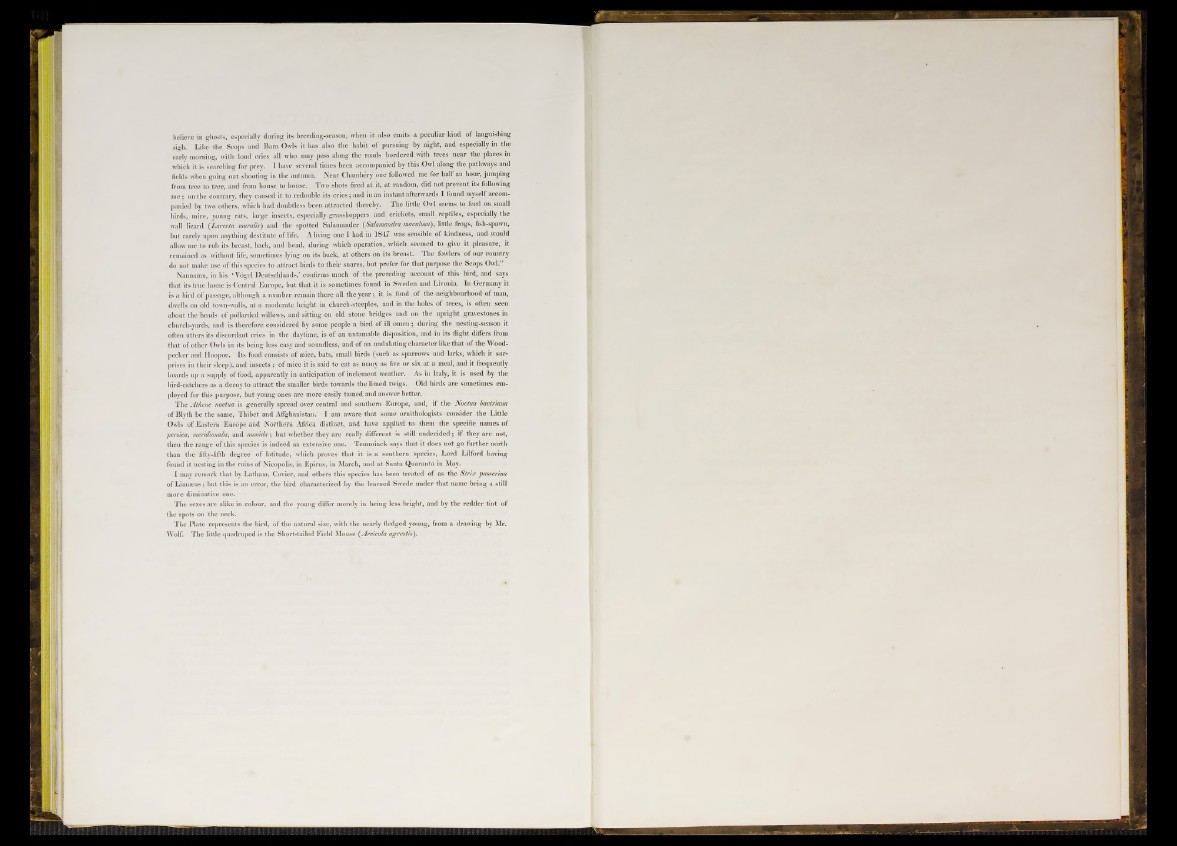
believe in ghosts, especially during its breediug-season, when it also emits a peculiar kiud of languishing
sigh. Like the Scops and Barn Owls it has also the habit o f pursuing by night, and especially in the
early morning, with loud cries all who may pass along the roads bordered with trees near the places in
which it is searching for prey. I have several times been accompanied by this Owl along the pathways and
fields when going out shooting in the autumn. Near Chambery one followed me for half an hour, jumping
from tree to tree, and from house to house. Two shots fired a t it, at random, did not prevent its following
me j on the contrary, they caused it to redouble its c rie s ; and in an instant afterwards I found myself accompanied
by two others, which had doubtless been attracted thereby. The little Owl seems to feed on small
birds, mice, young rats, large insects, especially grasshoppers and crickets, small reptiles, especially the
wall lizard (Lacerta muralis) and the spotted Salamander (Salamandra maculosa), little frogs, fish-spawn,
but rarely upon anything destitute of life. A living one I had in 1847 was sensible o f kindness, and would
allow me to rub its breast, back, and head, during which operation, which seemed to give it pleasure, it
remained as without life, sometimes lying on its back, a t others on its breast. The fowlers o f our country
do not make use of this species to attract birds to their snares, but prefer for that purpose the Scops Owl.
Naumann, in his ‘Vogel Deutschlands,’ confirms much o f the preceding account o f th is' bird, and says
that its true home is Central Europe, but that it is sometimes found in Sweden and Livonia. In Germany it
is a bird o f passage, although a number remain there all the y e a r; it is fond o f the neighbourhood o f man,
dwells on old town-walls, at a moderate height in church-steeples, and in the holes of trees, is often seen
about the heads of pollarded willows, and sitting on old stone bridges and on the upright gravestones in
church-yards, and is therefore considered by some people a bird of ill omen; during the nesting-season it
often utters its discordant cries in the daytime, is o f an untamable disposition, and in its flight differs from
that of other Owls in its being less easy and soundless, and o f an undulating character like that of the Woodpecker
and Hoopoe. Its food consists of mice, bats, small birds (such as sparrows and larks, which i t surprises
in their sleep), and insects ; o f mice it is said to eat as many as five or six a t a meal, and it frequently
hoards up a supply of food, apparently in anticipation of inclement weather. As in Italy, it is used by the
bird-catchers as a decoy to attract the smaller birds towards the limed twigs. Old birds are sometimes employed
for this purpose, but young ones are more easily tamed and answer better.
The Athene noctua is generally spread over central and southern Europe, and, if the Noctna bactriana
of Blyth be the same, Thibet and Affghanistan. I am aware th at some ornithologists consider the Little
Owls of E astern Europe and Northern Africa distinct, and have applied to them the specific names of
persica, meridionalis, and numida; but whether they are really different is still undecided; if they are not,
then the range of this species is indeed an extensive one. Temminck says that it does not go further north
than the fifty-fifth degree o f latitude, which proves that it is a southern species, Lord Lilford having
found it nesting in the ruins o f Nicopolis, in Epirus, in March, and a t Santa Quaranta in May.
I may remark that by Latham, Cuvier, and others this species has been treated of as the S lrix passerina
of Linnaeus; but this is an error, the bird characterized by the learned Swede under that name being a still
more diminutive one.
The sexes are alike in colour, and the young differ merely in being less bright, and by the redder tint of
the spots on the neck.
The Plate represents the bird, of the natural size, with the nearly fledged young, from a drawing by Mr.
Wolf. The little quadruped is the Short-tailed Field Mouse (Armenia agrestis).